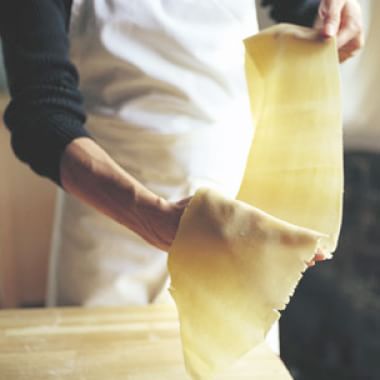
More tender and lighter in texture than its dried counterpart, fresh pasta is traditionally tossed with sauces that include cream and butter. Heartier dried pasta is better suited to robust meat sauces.
Mixing, Rolling and Cutting
With a bit of practice, you'll find it's easy to make fresh pasta at home. A basic pasta dough includes all-purpose or semolina flour (or a combination) plus eggs. Feel free to experiment by adding other ingredients for color and subtle flavor, such as spinach, tomatoes, beets, saffron, lemon or squid ink.
You can mix the dough by hand, in a food processor or in an electric mixer. Rolling and cutting out the dough may be accomplished by hand or with a pasta machine. You can cut fresh pasta into various-shaped noodles, such as spaghetti or fettuccine, ready to be cooked and tossed with a sauce. Or use the pasta sheets to create filled pastas, such as ravioli. A sheet of fresh pasta can become a canvas for a wide range of shapes and flavorful fillings.
Storing
After cutting fresh pasta, you can cook it immediately or refrigerate it. If not cooking pasta noodles right away, let them dry on a baking sheet for 1 to 2 minutes, dust well with flour so the strands will not stick together, and loosely fold them or form into small nests. Let dry for about 30 minutes more, then wrap and refrigerate for up to 2 days. The pasta may be frozen for up to 2 weeks.
Cooking
Cook fresh pasta noodles in a large pot of boiling salted water. (Use about 6 quarts of water for 1 pound of pasta.) Fresh pasta takes considerably less time to cook than dried, usually 1 to 3 minutes, so watch it carefully. To test, remove a noodle with tongs or a long-handled fork and take a bite. Pasta is best when cooked al dente (tender but firm to the bite). As soon as it is done, drain in a colander.
Because ravioli and other fresh filled pastas are delicate, they should be simmered gently, not boiled, so they will not break apart.
Mixing, Rolling and Cutting
With a bit of practice, you'll find it's easy to make fresh pasta at home. A basic pasta dough includes all-purpose or semolina flour (or a combination) plus eggs. Feel free to experiment by adding other ingredients for color and subtle flavor, such as spinach, tomatoes, beets, saffron, lemon or squid ink.
You can mix the dough by hand, in a food processor or in an electric mixer. Rolling and cutting out the dough may be accomplished by hand or with a pasta machine. You can cut fresh pasta into various-shaped noodles, such as spaghetti or fettuccine, ready to be cooked and tossed with a sauce. Or use the pasta sheets to create filled pastas, such as ravioli. A sheet of fresh pasta can become a canvas for a wide range of shapes and flavorful fillings.
Storing
After cutting fresh pasta, you can cook it immediately or refrigerate it. If not cooking pasta noodles right away, let them dry on a baking sheet for 1 to 2 minutes, dust well with flour so the strands will not stick together, and loosely fold them or form into small nests. Let dry for about 30 minutes more, then wrap and refrigerate for up to 2 days. The pasta may be frozen for up to 2 weeks.
Cooking
Cook fresh pasta noodles in a large pot of boiling salted water. (Use about 6 quarts of water for 1 pound of pasta.) Fresh pasta takes considerably less time to cook than dried, usually 1 to 3 minutes, so watch it carefully. To test, remove a noodle with tongs or a long-handled fork and take a bite. Pasta is best when cooked al dente (tender but firm to the bite). As soon as it is done, drain in a colander.
Because ravioli and other fresh filled pastas are delicate, they should be simmered gently, not boiled, so they will not break apart.
Adapted from
Williams-Sonoma Collection Series,
Pasta,
by Erica De Mane
(Simon & Schuster, 2001).













